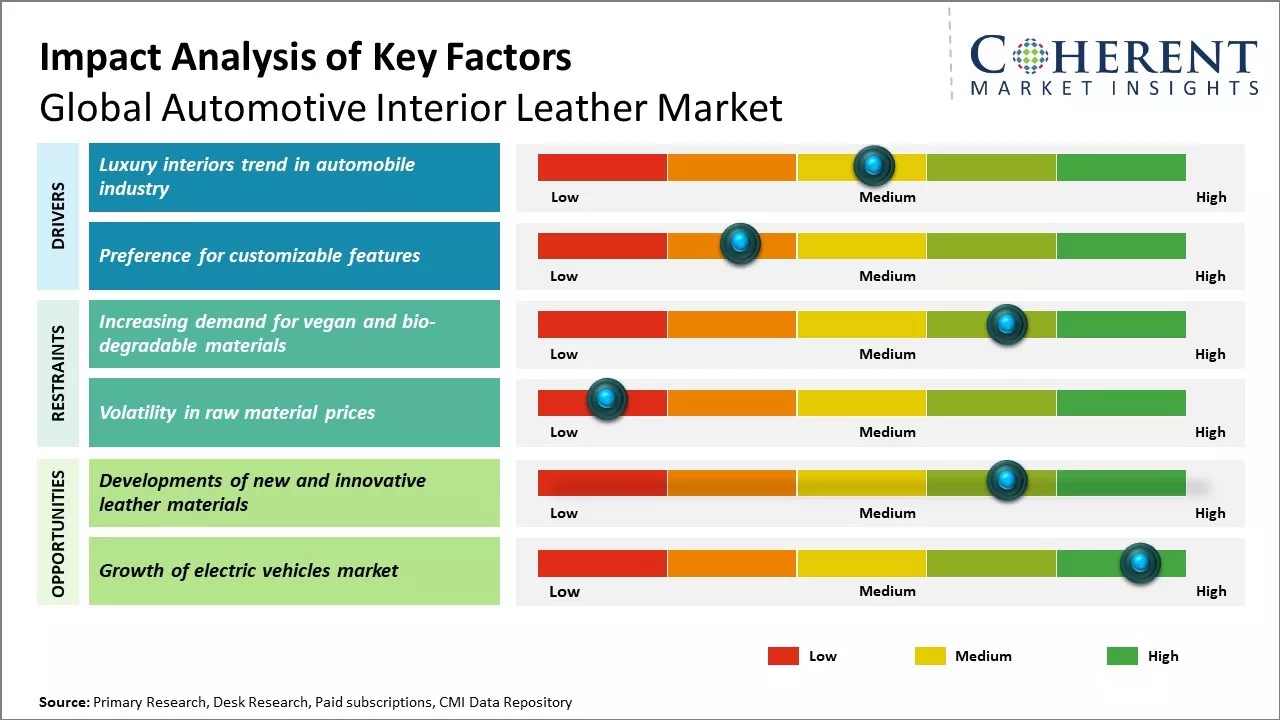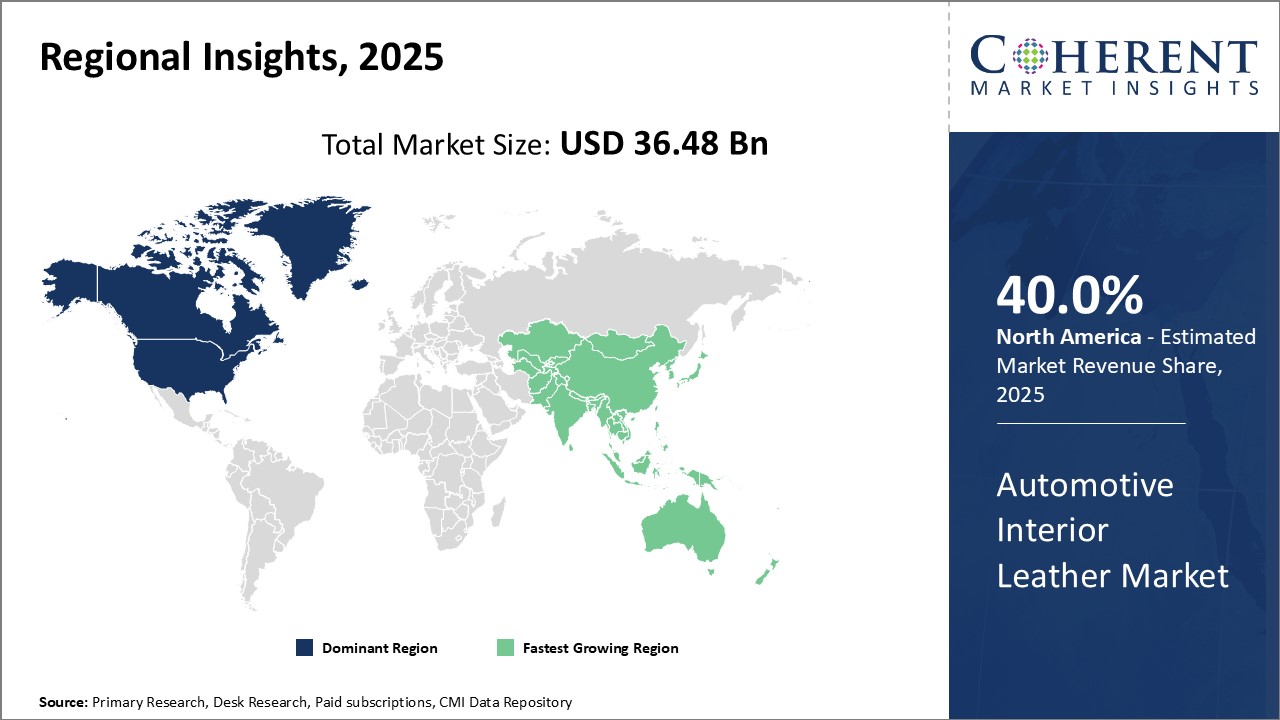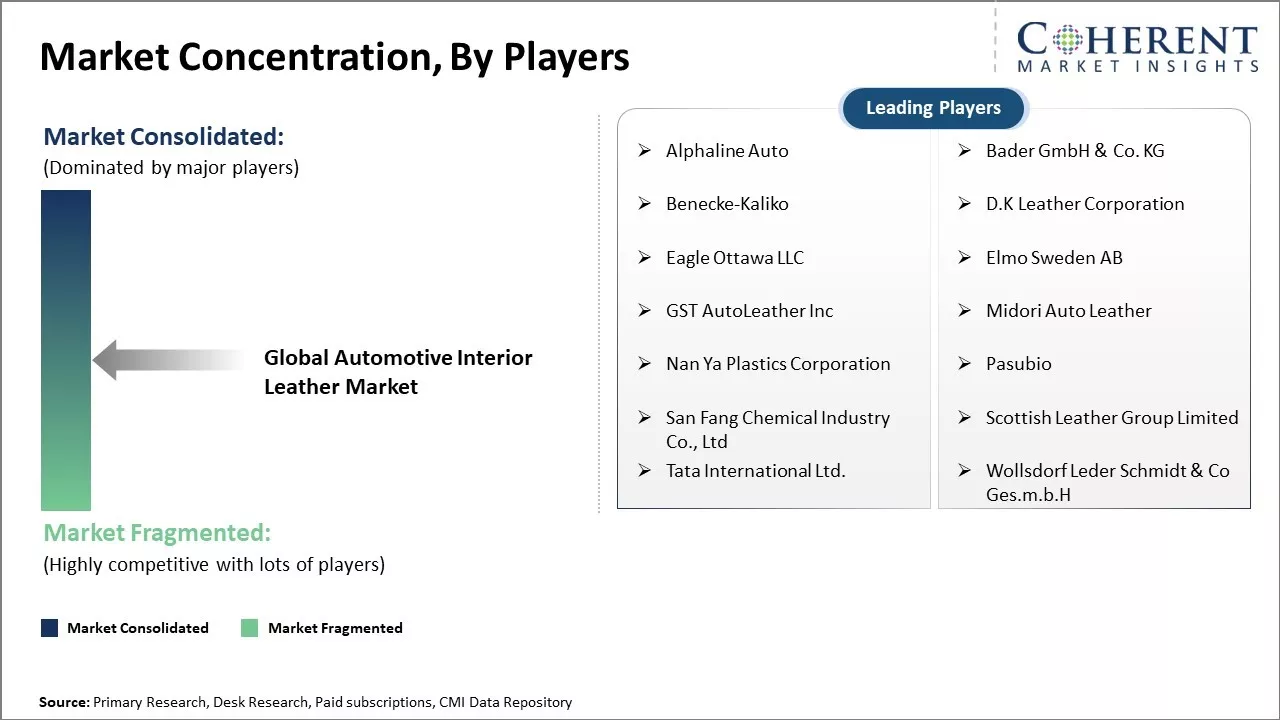The Global Automotive Interior Leather Market size is estimated to be valued at USD 36.48 Bn in 2025 and is expected to reach USD 57.85 Bn by 2032, exhibiting a compound annual growth rate (CAGR) of 6.8% from 2025 to 2032.

To learn more about this report, Download Free Sample
Vehicle owners enjoy the comfort, style, and premium appeal provided by leather upholstery. Customers are now buying luxury vehicles with leather interiors because of increased disposable income. In order to meet distinct market segments, manufacturers are offering polyurethane leather and synthetic leather, but they also have to consider the stringent vehicle emission regulations which may slow the demand for leather interiors in the future.
|
Event |
Description and Impact |
|
Geopolitical Trade Policy Changes |
|
|
Environmental Compliance Mandates |
|
|
Supply Chain Reconfiguration |
|
Uncover macros and micros vetted on 75+ parameters: Get instant access to report
The development of bio-based automotive interior leather is gaining momentum as the auto industry shifts toward sustainable materials. Made from renewable resources like industrial hemp, mycelium, or plant oils, these alternatives aim to reduce reliance on animal leather and synthetic plastics.
In September 2024, Volkswagen partnered with German start-up Revoltech GmbH to develop LOVR, a 100% bio-based leather alternative made from industrial hemp. Fully recyclable and compostable, LOVR is designed for car interiors and could appear in Volkswagen models by 2028. The material is compatible with existing manufacturing processes, allowing for scalable production.
In terms of material, the genuine segment is estimated to hold 65.2% share in 2025 of the global automotive interior leather market demand due to its cost-effectiveness and easy maintenance qualities compared to synthetic leather.
Among vehicle types, the passenger car segment is estimated to hold 40.8% share in 2025 of the automotive interior leather market due to higher unit volumes and priority on onboard experience. The automotive interior leather market is a key differentiator for both mass-market and premium vehicle segments globally. Leather upholstery provides superior comfort, support, and breathability, enhancing the driving experience
Among applications, the seats and center stack segment is estimated to hold the 34.3% share in 2025 of the automotive leather market. This is because drivers and passengers interact most directly with these surfaces on a regular basis. Automakers prioritize innovative leather-based solutions for high-touch areas of the vehicle interior, as they significantly influence perceived quality and luxury. Leather-wrapped seats provide superior ergonomics, support, and aesthetics, enhancing the overall in-cabin experience.

To learn more about this report, Download Free Sample
North America is estimated to dominate the global automotive interior leather market trend with 40.0% share in 2025. The large-scale automotive production that takes place in countries like U.S. and Canada has ensured there is huge demand for leather. Major automakers in North America prefer using high quality leather upholstery for most premium and luxury vehicles.
One region that has been witnessing astonishing growth is Asia Pacific. Especially countries like China, India and Malaysia have seen huge automotive production ramp-ups in recent years. Rising disposable incomes are pushing more consumers to buy cars with premium interiors. While these nations had largely imported automotive leather earlier, their domestic industries are fast catching up.
| Report Coverage | Details | ||
|---|---|---|---|
| Base Year: | 2024 | Market Size in 2025: | USD 36.48 Bn |
| Historical Data for: | 2020 To 2024 | Forecast Period: | 2025 To 2032 |
| Forecast Period 2025 to 2032 CAGR: | 6.8% | 2032 Value Projection: | USD 57.85 Bn |
| Geographies covered: |
|
||
| Segments covered: |
|
||
| Companies covered: |
Alphaline Auto, Bader GmbH & Co. KG, Benecke-Kaliko, D.K Leather Corporation, Eagle Ottawa LLC, Elmo Sweden AB, GST AutoLeather Inc, Midori Auto Leather, Nan Ya Plastics Corporation, Pasubio, San Fang Chemical Industry Co., Ltd, Scottish Leather Group Limited, Tata International Ltd., and Wollsdorf Leder Schmidt & Co Ges.m.b.H |
||
| Growth Drivers: |
|
||
| Restraints & Challenges: |
|
||
Uncover macros and micros vetted on 75+ parameters: Get instant access to report

To learn more about this report, Download Free Sample
The automobile sector has seen prominent growth in demand for luxury automobiles in all major markets during the past few years. Customers purchasing automobiles pay more attention to features and are ready to pay a premium for better design, comfort, and overall experience. Leather as an interior surface has practically become a hallmark of luxury and sophisticated design in mid to upper range vehicles. Leather seats is regarded as a status symbol and its light fluffy texture accentuates the feeling of luxury. Even entry level models from most luxury brands are now outfitted with fully leather-covered interiors as standard.
For example, in July 2022 Sage-ONF, a synthetic leather supplier with 29 years’ experience in design and development, manufacturing and selling, announced the start of serial production of their innovative silicone synthetic leather for automotive interiors.
Customers nowadays want their vehicles to represent their personalities; hence they look for configurable options which allow personalization at the design level. The automobile interior industry has experienced a significant change in the direction of offering customers a wide range of options regarding materials, such as constituent parts, textiles, colors, graphics, and treatment designs.
The development of new innovative leather materials offers a great opportunity to drive growth in the global automotive interior leather market forecast. Automotive interiors are increasingly demanding high quality, sustainable and technologically advanced leather materials.
For example, MuSkin - a leather-like material created from food waste by Anthropic using AI-tools, is 100% compostable and uses byproducts rather than animal skins. Such innovations cater to consumers who prefer sustainable interior décor.
*Definition: The global automotive interior leather market includes leather products used for interior automotive components like seats, door panels, instrument panels, headliners, and other interior trims. Leather is a popular material for vehicle interiors due to its premium and luxurious aesthetic appeal. The global market covers suppliers of automotive leather and tanned hides that are purchased by automakers and used in the manufacturing of various interior parts. Key players in this market focus on developing innovative and stylish leather materials to enhance the comfort, appearance, and value of vehicle cabins
Share
Share
About Author
Ameya Thakkar is a seasoned management consultant with 9+ years of experience optimizing operations and driving growth for companies in the automotive and transportation sector. As a senior consultant at CMI, Ameya has led strategic initiatives that have delivered over $50M in cost savings and revenue gains for clients. Ameya specializes in supply chain optimization, process re-engineering, and identification of deep revenue pockets. He has deep expertise in the automotive industry, having worked with major OEMs and suppliers on complex challenges such as supplier analysis, demand analysis, competitive analysis, and Industry 4.0 implementation.
Missing comfort of reading report in your local language? Find your preferred language :
Transform your Strategy with Exclusive Trending Reports :
Frequently Asked Questions
Joining thousands of companies around the world committed to making the Excellent Business Solutions.
View All Our Clients